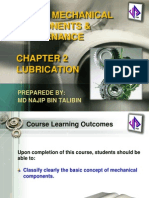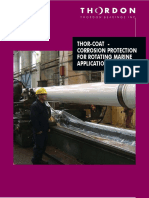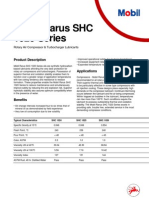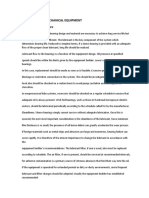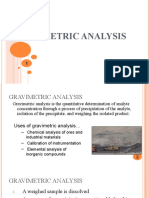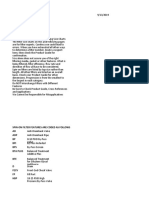Bearing Cleaning Eng PDF
Bearing Cleaning Eng PDF
Uploaded by
Adam SamyCopyright:
Available Formats
Bearing Cleaning Eng PDF
Bearing Cleaning Eng PDF
Uploaded by
Adam SamyOriginal Description:
Original Title
Copyright
Available Formats
Share this document
Did you find this document useful?
Is this content inappropriate?
Copyright:
Available Formats
Bearing Cleaning Eng PDF
Bearing Cleaning Eng PDF
Uploaded by
Adam SamyCopyright:
Available Formats
Bearing lubricating procedures
Bearing cleaning
The removal of any existing oils, greases and anti-corrosion coatings increases in importance as the operating life
and reliability of the application becomes more and more critical. The wetting of the contact surface by the lubricating
film will be enhanced by a clean contact surface. Removal of these oils, greases and coatings will also eliminate any
potential incompatibilities that may exist between these products and the subject lubricant. It is always advisable to
remove these materials prior to applying silicone or perfluorinated based products.
Existing surface coatings can act as separating agents, preventing the applied grease from wetting the bearing balls
*
and races properly. For applications which operate in the high speed range (nDm > 800,000 or n/ng > 0.8), a clean
dry surface may be necessary to ensure the proper adhesion between the grease thickener matrix and the bearing
surfaces.
Many bearing companies provide their products pre-coated with an oil film and/or anti-corrosion coating. If this
coating has both a micro-thickness and is compatible with the chosen lubricant, then a pre-cleaning operation may
not be necessary. It is important to discuss this situation with the subject bearing and lubricant supplier.
Use of a non-residual solvent for the cleaning of bearing surfaces provides the optimum lubrication condition. Prior
to selecting a suitable industrial solvent, it is important to refer to any applicable federal, state, local or plantwide
regulations regarding their restrictions or proper use.
The most efficient non-residual solvents were CFC-113 (Freon TF) and methyl chloroform (1,1,1 Trichloroethane).
However, restrictions on ozone depleting chemicals prohibit the use of these solvent types. In this case, the best
allowable non-residual solvent should be used (see chart below).
The application criteria, along with the degree of contamination, will determine the extent of cleaning and whether
multiple cleanings or ultrasonic cleaning is necessary.
As the cleaned parts dry, they become prone to atmospheric corrosion. If immediate lubrication is not possible, the
parts should be coated with a dispersion of the intended lubricant prior to storage. Even if the bearings are
immediately lubricated, the "non-lubricated" surfaces are still prone to corrosion. Therefore it is advisable to apply a
light anti-corrosion coating to these bearing surfaces after lubrication.
Bearing Cleaning Options
Non-Residual Solvents
Alternatives (leave residue)**
Hydrochlorofluorocarbons*
(HCFC-141B)
HydroFluorether
(HFE)
Aliphatic
Esters
Organic
Solvents
(Mineral
Spirits,
Kerosene)
Alkali /
Aqueous
Cleaners
Chlorofluorocarbons
* (CFC-113)
Methyl
Chloroform*
(1,1,1
Trichloroethan
e)
Perchlorethylene
Trichloroethylene
* Methylene
Chloride
Anti-Corrosion
Coatings
Mineral Oil
products
PAO / Ester
products
Silicone
products
Product to be
cleaned
Fluorohexane
(Kluberalfa
XZ 3-1)
PFPE products
3
* indicates a chlorinated type
** after using a residual cleaner, rinse with clean water and lubricate immediately
Klber Lubrication Mnchen KG, a member of the Freudenberg group
Publisher and Copyright:
Klber Lubrication Mnchen KG
Reprints, total or in part, are permitted if source
is indicated and voucher copy is forwarded.
Klber Lubrication Mnchen KG
Geisenhausenerstrae 7, 81379 Mnchen, Germany
( +49 89 7876-0, Telefax +49 89 7876-333
You might also like
- Machinery Lubrication Specialist MaterialsDocument219 pagesMachinery Lubrication Specialist MaterialsBatoktoy100% (13)
- MLT Preparation Handbook Section 1Document22 pagesMLT Preparation Handbook Section 1BHOOPALA KRISHNAN MOTHILAL100% (2)
- Bearing DesignDocument58 pagesBearing DesignCaryann Gumban100% (1)
- Sealants & SealingDocument19 pagesSealants & Sealingslam12125No ratings yet
- Detailers Dictionary: Detailers Little Black BookFrom EverandDetailers Dictionary: Detailers Little Black BookRating: 5 out of 5 stars5/5 (1)
- CUTTING FLUIDS... WikipediaDocument6 pagesCUTTING FLUIDS... WikipediaRaushan JhaNo ratings yet
- KL Bearing - Lubricating - ProceduresDocument9 pagesKL Bearing - Lubricating - ProcedureswelsonNo ratings yet
- Lubricants Fundamental Article - Sergio Nicolas Cardenas ZipaDocument3 pagesLubricants Fundamental Article - Sergio Nicolas Cardenas ZipaLaura PinillaNo ratings yet
- Marine TribologyDocument79 pagesMarine TribologyRam GovindasamyNo ratings yet
- Tribology in Marine ApplicationsDocument19 pagesTribology in Marine ApplicationsNeeraj RajpalNo ratings yet
- Paper-1 Lubrication EngineeringDocument98 pagesPaper-1 Lubrication EngineeringjoelprithivNo ratings yet
- Formwork Release AgentsDocument6 pagesFormwork Release AgentsRajendra DuttaNo ratings yet
- Inter Plant Standardization - Steel IndustryDocument20 pagesInter Plant Standardization - Steel Industrythiru_jsrNo ratings yet
- Lubrication Principles: Learning OutcomeDocument12 pagesLubrication Principles: Learning OutcomeMandeep MalikNo ratings yet
- Introduction and LubricationDocument9 pagesIntroduction and LubricationslchemNo ratings yet
- Lubrication Types and GradesDocument6 pagesLubrication Types and Gradesroopa m0% (1)
- Lubrication For Journal BearingDocument25 pagesLubrication For Journal BearingNguyễn Thanh Sơn100% (1)
- Lubrication Is The Process or Technique Employed To Reduce Friction Between, and Wear of One orDocument10 pagesLubrication Is The Process or Technique Employed To Reduce Friction Between, and Wear of One orFashwan FathullahNo ratings yet
- Chapter 2 - LubricationDocument22 pagesChapter 2 - LubricationMr Mickey83% (6)
- Lubrication ProjectDocument23 pagesLubrication ProjectAaron Palm100% (1)
- Application Professional Micron66 ENGDocument4 pagesApplication Professional Micron66 ENGJoventino AlvesNo ratings yet
- Cleaning and CorrosionDocument19 pagesCleaning and CorrosionJuly TadeNo ratings yet
- US XX Mobil SolvancerDocument3 pagesUS XX Mobil SolvancerRodolfo GlauberNo ratings yet
- What You Need To Know When Selecting Gear OilsDocument5 pagesWhat You Need To Know When Selecting Gear OilsmarciofelipessantosNo ratings yet
- Lubrication 141218114335 Conversion Gate01Document17 pagesLubrication 141218114335 Conversion Gate01prashantNo ratings yet
- Lubs, Properties & TeatingDocument33 pagesLubs, Properties & Teatingjamesv52_7439427860% (1)
- Lubrication For Linear Bearings RacewaysDocument7 pagesLubrication For Linear Bearings RacewaysDaniel0010No ratings yet
- CHY1005 Module 02 - TRIBOLOGY Class NotesDocument77 pagesCHY1005 Module 02 - TRIBOLOGY Class Notessrikar princeNo ratings yet
- Lubrication BasicsDocument3 pagesLubrication BasicsVenkatesh RjNo ratings yet
- CorrosionX GreaseDocument3 pagesCorrosionX Greasendnguyen.hustNo ratings yet
- Chapter 7 Lubricants in Refrigerant SystemsDocument57 pagesChapter 7 Lubricants in Refrigerant SystemsJose MendozaNo ratings yet
- GL XX Mobil Brake Fluid DOT 4Document2 pagesGL XX Mobil Brake Fluid DOT 4Julio GuillermoNo ratings yet
- Plain Bearing ReportDocument15 pagesPlain Bearing Reportpresident fishrollNo ratings yet
- 04importance of LubricationDocument8 pages04importance of LubricationSheensky V. SalasaNo ratings yet
- Types of Lubricants: LubricationDocument2 pagesTypes of Lubricants: Lubrication050370No ratings yet
- Interthane 990 HS DatasheetDocument4 pagesInterthane 990 HS DatasheetBalasubramanian Ananth100% (1)
- ENB 04 0555 Rev B Bearing Lubrication PDFDocument5 pagesENB 04 0555 Rev B Bearing Lubrication PDFIrwan SyahNo ratings yet
- Tribology Module 01 NotesDocument19 pagesTribology Module 01 NotesVinayaka G P90% (10)
- Improving Chain LubricationDocument5 pagesImproving Chain LubricationAhmadreza AminianNo ratings yet
- Sleeve or Plain Bearing LubricationDocument3 pagesSleeve or Plain Bearing LubricationVolety_Sarma_1703100% (1)
- Molykote Lubrication BrochureDocument12 pagesMolykote Lubrication BrochureLiam MoylanNo ratings yet
- Rex ThaneDocument4 pagesRex Thanesas999333No ratings yet
- Thor-Coat - Corrosion Protection For Rotating Marine ApplicationsDocument4 pagesThor-Coat - Corrosion Protection For Rotating Marine Applicationsmaria_bustelo_2No ratings yet
- Mobil Rarus SHC 1000 SeriesDocument3 pagesMobil Rarus SHC 1000 SeriesdaumoNo ratings yet
- Lubricant Oil System MaintenanceDocument2 pagesLubricant Oil System MaintenancePaul AbonitaNo ratings yet
- LubricationsDocument80 pagesLubricationsVANSH BHATI100% (3)
- Lubrication GuideDocument28 pagesLubrication GuideVarun PineamaneniNo ratings yet
- Tribo Losses in TransmissionDocument29 pagesTribo Losses in Transmissionjamesv52_743942786100% (1)
- LubricationDocument49 pagesLubricationAdel KlkNo ratings yet
- Engineering Chemistry (Lubricant) FinalDocument16 pagesEngineering Chemistry (Lubricant) FinalJGHH,J,100% (1)
- Approved: - Vice-General Director of XADO Chemical Corporation I. A. BurushkinDocument19 pagesApproved: - Vice-General Director of XADO Chemical Corporation I. A. Burushkindalton2004No ratings yet
- Steelmaster 60WB: Technical Data Sheet Application GuideDocument10 pagesSteelmaster 60WB: Technical Data Sheet Application GuideyugandharNo ratings yet
- Module 4. Lubricant & Lubrication PDFDocument65 pagesModule 4. Lubricant & Lubrication PDFarcee coin100% (1)
- A11.13 - Mobil Rarus SHC 1020Document2 pagesA11.13 - Mobil Rarus SHC 1020Dony LieNo ratings yet
- Mechanical Parts MaitenanceDocument2 pagesMechanical Parts MaitenanceNaveedNo ratings yet
- AG 15400 Steelmaster+120SB Euk GBDocument10 pagesAG 15400 Steelmaster+120SB Euk GBparathasiNo ratings yet
- Machinery Oil Analysis & Condition Monitoring : A Practical Guide to Sampling and Analyzing Oil to Improve Equipment ReliabilityFrom EverandMachinery Oil Analysis & Condition Monitoring : A Practical Guide to Sampling and Analyzing Oil to Improve Equipment ReliabilityRating: 3.5 out of 5 stars3.5/5 (5)
- Residential Asphalt Roofing Manual Design and Application Methods 2014 EditionFrom EverandResidential Asphalt Roofing Manual Design and Application Methods 2014 EditionNo ratings yet
- General CatalogDocument115 pagesGeneral CatalogAdam SamyNo ratings yet
- TechTalk-Magnetic Flowmeter SizingDocument1 pageTechTalk-Magnetic Flowmeter SizingAdam SamyNo ratings yet
- 2/2 Way Solenoid Valve - BC-40Document1 page2/2 Way Solenoid Valve - BC-40Adam SamyNo ratings yet
- S103C E - Magnetici Flowmter CH2200 - 2500 Flanged PipeDocument7 pagesS103C E - Magnetici Flowmter CH2200 - 2500 Flanged PipeAdam SamyNo ratings yet
- Pressure Switch in Hydraulic or Pneumatic Design For Mining and ChemistryDocument2 pagesPressure Switch in Hydraulic or Pneumatic Design For Mining and ChemistryAdam SamyNo ratings yet
- MODEL 703-U: Description FeaturesDocument2 pagesMODEL 703-U: Description FeaturesAdam Samy0% (1)
- Sor Adjustable Dead Band Pressure SwitchDocument16 pagesSor Adjustable Dead Band Pressure SwitchAdam SamyNo ratings yet
- Product Catalogue: Minicomb EDSDocument8 pagesProduct Catalogue: Minicomb EDSAdam SamyNo ratings yet
- SGSM 3000, SGCM 3000, SGCO 3000 53414-4-MM, Rev 4 09-08-1Document2 pagesSGSM 3000, SGCM 3000, SGCO 3000 53414-4-MM, Rev 4 09-08-1Adam SamyNo ratings yet
- S103C E - Magnetici Flowmter CH608 ConverterDocument2 pagesS103C E - Magnetici Flowmter CH608 ConverterAdam SamyNo ratings yet
- Honeywell Sensing Switch 5000 Series ProductsheetDocument2 pagesHoneywell Sensing Switch 5000 Series ProductsheetAdam SamyNo ratings yet
- MODEL 768-S: Fixed Setting Design Diaphragm Switch Low Pressure: 3 To 125 PSIG Vacuum Sensing: 3" To 26" HGDocument2 pagesMODEL 768-S: Fixed Setting Design Diaphragm Switch Low Pressure: 3 To 125 PSIG Vacuum Sensing: 3" To 26" HGAdam SamyNo ratings yet
- MODEL 703-UJ: Description FeaturesDocument2 pagesMODEL 703-UJ: Description FeaturesAdam SamyNo ratings yet
- What Is EE DocDocument4 pagesWhat Is EE DocAdam SamyNo ratings yet
- Barksdale 7000pRESSUREDocument4 pagesBarksdale 7000pRESSUREAdam SamyNo ratings yet
- Purolite Ion ExchangeDocument20 pagesPurolite Ion Exchangegnino2No ratings yet
- Technology and Indian Market Scenario-Mining ChemicalDocument105 pagesTechnology and Indian Market Scenario-Mining ChemicalbharatchemtechNo ratings yet
- Dokumen - Tips - New Waterborne Technologies For The Formulation of The Formulation of Problem SolvingDocument41 pagesDokumen - Tips - New Waterborne Technologies For The Formulation of The Formulation of Problem SolvingLong An Đỗ100% (1)
- Mold Control Mold Armor Mold Remover FG550 - SDS-86-M-2 PDFDocument5 pagesMold Control Mold Armor Mold Remover FG550 - SDS-86-M-2 PDFjmarrero488307No ratings yet
- Assingment Question 5 ... FinalDocument4 pagesAssingment Question 5 ... Finalben makoreNo ratings yet
- Nayakem: Product Data Sheet DBMDocument1 pageNayakem: Product Data Sheet DBMAnonymous C3BD7OdNo ratings yet
- Prevention of CorrosionDocument10 pagesPrevention of CorrosionOmar GamalNo ratings yet
- Adhesives Presentation 2Document25 pagesAdhesives Presentation 2api-614059080No ratings yet
- Chapter 6Document33 pagesChapter 6Solomon DesalegnNo ratings yet
- Gravimetric AnalysisDocument21 pagesGravimetric AnalysisAli MohammadNo ratings yet
- Brand AQAGloss-Brochure - Product Overview Polymer Dispersions Architectural Coatings-EnglishDocument6 pagesBrand AQAGloss-Brochure - Product Overview Polymer Dispersions Architectural Coatings-EnglishPaul ChendeNo ratings yet
- Cambridge O Level: CHEMISTRY 5070/41Document12 pagesCambridge O Level: CHEMISTRY 5070/41RAHIMAH BASIUNINo ratings yet
- Ozone Treatment For Cooling Towers and Potable WaterDocument19 pagesOzone Treatment For Cooling Towers and Potable Waternetygen1No ratings yet
- Slag Fundamentals & Phase DiagramsDocument38 pagesSlag Fundamentals & Phase DiagramsNicole Altamirano Catalán100% (2)
- Measuring SolubilityDocument15 pagesMeasuring Solubilitymaverickx528No ratings yet
- Welding Defects & TestsDocument27 pagesWelding Defects & TestsAbhishek SinhaNo ratings yet
- 14.analysis of Epoxy Resin With Natural MaterialsDocument7 pages14.analysis of Epoxy Resin With Natural MaterialsRavi CNo ratings yet
- Aerolite 111Document2 pagesAerolite 111amzsoftNo ratings yet
- Quiz 1 - SolutionDocument2 pagesQuiz 1 - Solutionhimadrisahu88No ratings yet
- Ethylene Oxide Sterilization PDFDocument2 pagesEthylene Oxide Sterilization PDFRobertNo ratings yet
- M08 K3LH Di PLANT - Pama - Rev1 For Mec (180411)Document115 pagesM08 K3LH Di PLANT - Pama - Rev1 For Mec (180411)TRAINING CENTER PT RMKENo ratings yet
- Effects of Solvents and Surfactant Agents On The Female and Larvae of Cattle Tick Boophilus MicroplusDocument4 pagesEffects of Solvents and Surfactant Agents On The Female and Larvae of Cattle Tick Boophilus MicroplusIsabela SantosNo ratings yet
- Nitric Acid (SUMMARY CHEMISTRY CHAPTER)Document2 pagesNitric Acid (SUMMARY CHEMISTRY CHAPTER)the lillyNo ratings yet
- 12 Chemistry FinalDocument24 pages12 Chemistry Finalvenkat gantaNo ratings yet
- Diffusivity of MEA in WaterDocument7 pagesDiffusivity of MEA in WaterHeng-Ji ChanNo ratings yet
- Brandstaedter Willi MichaelDocument202 pagesBrandstaedter Willi MichaelApril JuneNo ratings yet
- Multiple Choice Questions: Petroleum Products 1985Document13 pagesMultiple Choice Questions: Petroleum Products 1985api-3826629No ratings yet
- Finamul 87Document1 pageFinamul 87Minh Nguyen ThanhNo ratings yet
- EMAM Baldwin Filter Size ChartsDocument370 pagesEMAM Baldwin Filter Size ChartsYaseen ShaikNo ratings yet
- United States: (12) Patent Application Publication (10) Pub. No.: US 2011/0086848 A1Document14 pagesUnited States: (12) Patent Application Publication (10) Pub. No.: US 2011/0086848 A1梅汉No ratings yet




















